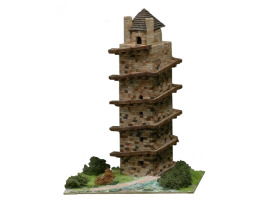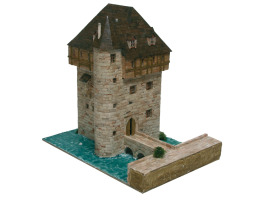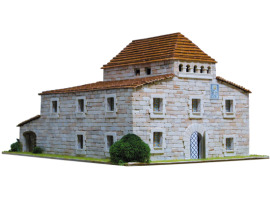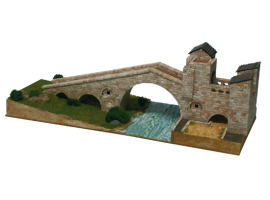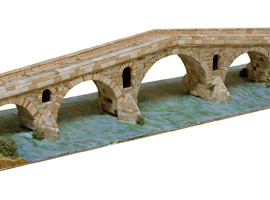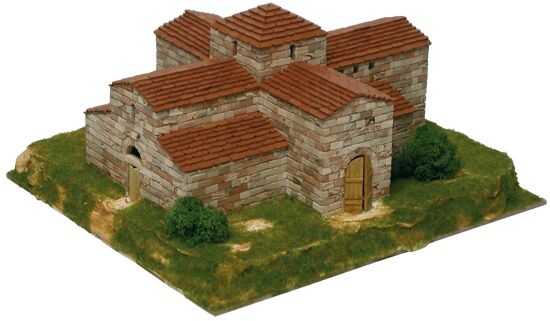
Ceramic constructor - Church of San Pedro de la Nave (IGLESIA DE SAN PEDRO DE LA NAVE)
Ceramic constructor - Church of San Pedro de la Nave (IGLESIA DE SAN PEDRO DE LA NAVE)
1 feedback
In stock
Article:
AA1102
Product weight, g:
1800
Number of details:
2 600
Box, height, cm:
27
Box thickness, cm:
5
Box, width, cm:
34
Scale:
1/80
Manufacturer:
Difficulty level:
середній
Ceramic constructor - Church of San Pedro de la Nave (IGLESIA DE SAN PEDRO DE LA NAVE), Aedes ars 1102
The set includes: cardboard frame, ceramic elements, landscape elements, instructions and glue
Size of the finished model: 11*25*28.8
The church of San Pedro de la Nave is located on the outskirts of Zamora, Castile and Leon, Spain.
This Visigothic church in the valley of the river Esla was moved to El Campiglio in 1930, 3 kilometers from its original site, which was flooded due to the construction of a reservoir.
Its appearance is very simple and strictly geometric: the plan of three naves is characterized by independent and lower roofs in the side naves. The transept appears to have been designed by adding two vestibules to the north and south.
The building is of good quality masonry and the exact date of construction is unknown, but must be either before 711 or between 893 and 907, as its presence is documented on the latter date and between 711 and 893 it was under Musli
The set includes: cardboard frame, ceramic elements, landscape elements, instructions and glue
Size of the finished model: 11*25*28.8
The church of San Pedro de la Nave is located on the outskirts of Zamora, Castile and Leon, Spain.
This Visigothic church in the valley of the river Esla was moved to El Campiglio in 1930, 3 kilometers from its original site, which was flooded due to the construction of a reservoir.
Its appearance is very simple and strictly geometric: the plan of three naves is characterized by independent and lower roofs in the side naves. The transept appears to have been designed by adding two vestibules to the north and south.
The building is of good quality masonry and the exact date of construction is unknown, but must be either before 711 or between 893 and 907, as its presence is documented on the latter date and between 711 and 893 it was under Musli
Description
Ceramic constructor - Church of San Pedro de la Nave (IGLESIA DE SAN PEDRO DE LA NAVE), Aedes ars 1102
The set includes: cardboard frame, ceramic elements, landscape elements, instructions and glue
Size of the finished model: 11*25*28.8
The church of San Pedro de la Nave is located on the outskirts of Zamora, Castile and Leon, Spain.
This Visigothic church in the valley of the river Esla was moved to El Campiglio in 1930, 3 kilometers from its original site, which was flooded due to the construction of a reservoir.
Its appearance is very simple and strictly geometric: the plan of three naves is characterized by independent and lower roofs in the side naves. The transept appears to have been designed by adding two vestibules to the north and south.
The building is of good quality masonry and the exact date of construction is unknown, but must be either before 711 or between 893 and 907, as its presence is documented on the latter date and between 711 and 893 it was under Musli
The set includes: cardboard frame, ceramic elements, landscape elements, instructions and glue
Size of the finished model: 11*25*28.8
The church of San Pedro de la Nave is located on the outskirts of Zamora, Castile and Leon, Spain.
This Visigothic church in the valley of the river Esla was moved to El Campiglio in 1930, 3 kilometers from its original site, which was flooded due to the construction of a reservoir.
Its appearance is very simple and strictly geometric: the plan of three naves is characterized by independent and lower roofs in the side naves. The transept appears to have been designed by adding two vestibules to the north and south.
The building is of good quality masonry and the exact date of construction is unknown, but must be either before 711 or between 893 and 907, as its presence is documented on the latter date and between 711 and 893 it was under Musli
Buy together
2 499 UAH
2 638 UAH
2 917 UAH
3 055 UAH
Reviews
Reviews
Also browsing with this item
1 feedback
2 499 UAH
1 feedback
2 638 UAH
1 feedback
2 917 UAH
1 feedback
3 055 UAH









